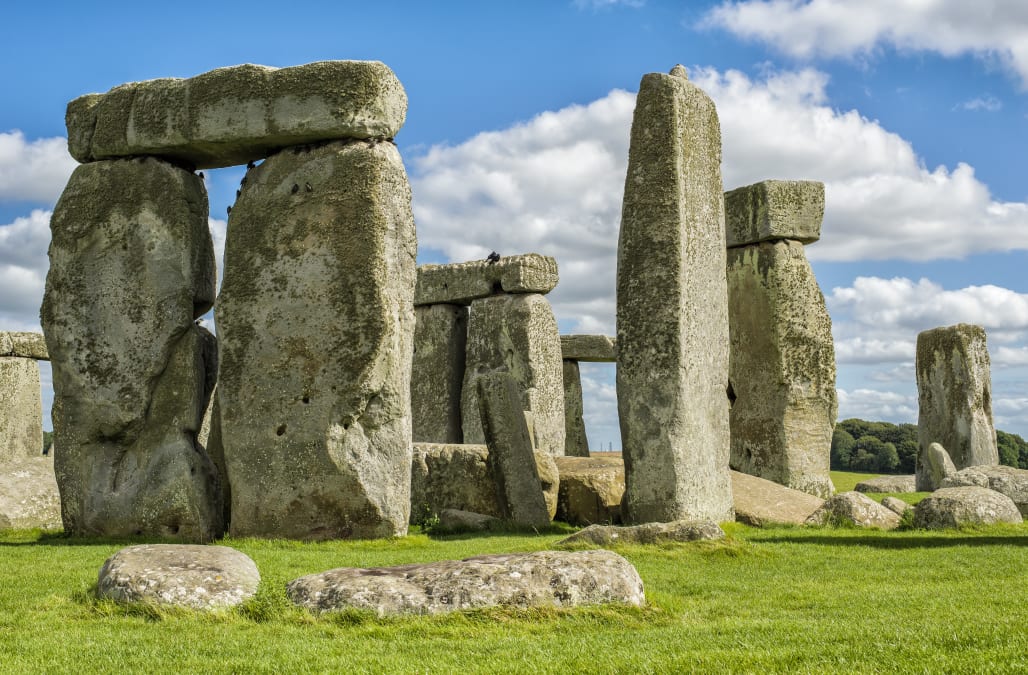(Reuters) – Scientists have solved an enduring mystery about Stonehenge, determining the origin of many of the megaliths that make up the famous monument in Wiltshire, England, thanks to a core sample that had been kept in the United States for decades.
Geochemical evidence indicates that 50 of Stonehenge’s 52 pale gray sandstone megaliths, known as sarsens, share a common origin about 15 miles (25 km) away at a site called West Woods on the edge of the Marlborough Downs from Wiltshire, investigators said Wednesday.
The sarsens were erected at Stonehenge around 2500 BC. C. The largest is 30 feet (9.1 meters) tall. The heaviest weighs around 30 tons.
“The Sarsen stones make up the iconic outer circle and central horseshoe of the trilithon (two vertical stones supporting a horizontal stone) at Stonehenge. They are huge,” said University of Brighton geomorphologist David Nash, who led the study published in Science Advances magazine.
“How they were transferred to the site is still really a matter of speculation,” Nash added. “Given the size of the stones, they must have been dragged or wheeled to Stonehenge. We don’t know the exact route, but at least we now have a starting point and an ending point.”
Stonehenge’s smallest bluestones previously dated back to Pembrokeshire in Wales, 150 miles (250 km) away, but the origin of the sarsens had defied identification.
13 PHOTOS
Stonehenge throughout history
See gallery
Restoration work at Stonehenge. (Photo by Brian Seed / The LIFE Images Collection / Getty Images)
Restoration work at Stonehenge, replacing stone in arches. (Photo by Brian Seed / The LIFE Images Collection / Getty Images)
circa 1911: a Bristol Prier monoplane from the Bristol Flying School in low flight over Stonehenge. (Photo from Hulton Archive / Getty Images)
STONEHENGE 1958: A 60-ton crane in use at Stonehenge, Salisbury Plain, Wiltshire, to lift a 20-ton slab of rock that is carefully cradled to distribute weight. The Ministry of Works is restoring one of the trilitons that crashed into the ground in 1797. (Photo from PA Images via Getty Images)
Stonehenge, Wiltshire. Reconstruction of the Trilithon 158 lintel by the 60-ton ‘Brabazon crane’, the larger of the two cranes used to lift stones. The lintel is being lowered and manipulated by man to its final resting position on vertical stones 57 and 58. (Photo by RJC Atkinson / English Heritage / Arcaid / Corbis via Getty Images)
March 28, 1958 – A sixty-ton crane, one of only two of its kind in the country, lifts an eighteen-ton lintel from a fallen trilithon at the ancient Stonehenge monument on Salisbury Plain in Wiltshire, England. . (Photo by John Franks / Keystone / Getty Images)
One of the massive pieces, No. 91 Station Stone, as the Ministry of Works knows it, is used for anchoring during preparations to straighten out some of the trilitons of Stonehenge, the prehistoric monument on the Salisbury Plain. (Photo from PA Images via Getty Images)
circa 1965: Stonehenge in the sun and shadow against a brilliant blue sky. (Photo by Ernst Haas / Ernst Haas / Getty Images)
SALISBURY, UK – JUNE 21: Solstice participants wait for the mid-summer sun to rise over the Stonehenge megalithic monument on June 21, 2007 in Salisbury Plain, England. Crowds gathered in the 5,000-year-old stone circle to celebrate the summer solstice; The longest day of the year in the northern hemisphere. (Photo by Scott Barbour / Getty Images)
Stonehenge, Amesbury, Salisbury, Wiltshire, England
Stonehenge is a prehistoric monument in Wiltshire, England, 2 miles (3 km) west of Amesbury and 8 miles (13 km) north of Salisbury. The standing stone ring of Stonehenge lies within the earthworks amid the densest complex of Neolithic and Bronze Age monuments in England, including several hundred burial mounds.
Stonehenge is a prehistoric monument in Wiltshire, England, 2 miles (3 km) west of Amesbury and 8 miles (13 km) north of Salisbury. The standing stone ring of Stonehenge lies within the earthworks amid the densest complex of Neolithic and Bronze Age monuments in England, including several hundred burial mounds.
Aerial view of Stonehenge, prehistoric monument and stone circle, UNESCO World Heritage Site, UK.
A sample of the Sarsen core, extracted during conservation work in the late 1950s when metal rods were inserted to stabilize a cracked megalith, provided crucial information. It was handed over as a souvenir to a man named Robert Phillips who worked for the company involved in the conservation work and was on site during the drilling.
Phillips took it with permission when he immigrated to the United States in 1977, living in New York, Illinois, California and finally Florida, Nash said. Phillips decided to return him to Britain for investigation in 2018. He died this year.
The researchers analyzed fragments of the sample (destructive evidence is beyond the reach of the megaliths at the site) to establish the geochemical footprint of the sarsen from which it was drawn. That fingerprint matched the sandstone still in West Woods and all but two of the Stonehenge are shadowed.
“I hope what we have discovered,” Nash said, “will allow people to understand more about the enormous effort involved in building Stonehenge.”
More of Aol.com:
Malik B, a founding member of The Roots, died at the age of 47.
The incipient tropical storm that knocks on Puerto Rico’s door could look to Florida below
Dodgers pitcher Joe Kelly suspended eight MLB games for pitching to the Astros.
